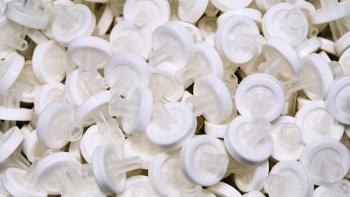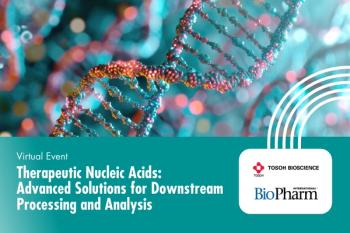
- BioPharm International-08-01-2010
- Volume 23
- Issue 8
Meningitis Vaccine Purification: Quality Control of Ultrafiltration Membrane Porosity
How to balance porosity, plugging, and lot-to-lot variability in filters.
ABSTRACT
The meningitis vaccine (NeisVac-C) comprises the de-O-acetylated form of group C meningococcal polysaccharide conjugated to tetanus toxoid. The polysaccharide purification process includes base treatment and subsequent diafiltration to remove hydrolyzed cell impurities. During development, a 100 kilodalton (kDa) nominal molecular weight cut-off (NMWCO) ultrafiltration membrane was used for the diafiltration, and process yields ranged from 87 to 135%. Unexpectedly, the yield from the first 12 production lots varied from 18 to 100%. Investigation revealed that ultrafiltration membrane porosity varied with different manufacturers' lots. The corrective action included changing from a 100 kDa to a 50 kDa NMWCO membrane; this change occurred just before license approval. To support the change, a process stream sample spiked with >200% of cell impurities was purified with the tightest 50 kDa membrane available. Even under this worst-case condition, the impurities were removed to meet the original specifications achieved by the 100 kDa membrane. The change was implemented and >100 lots have since been produced with satisfactory yield and purity.
NeisVac-C was introduced in the UK in the year 2000. Currently, it is licensed in 39 countries. The vaccine is used to prevent the invasive disease caused by Neisseria meningitidis serogroup C. The active ingredient of the vaccine is a polysaccharide–protein conjugate. Each dose of the vaccine contains 10 µg of de-O-acetylated group C meningococcal polysaccharide (GCMP) conjugated to 10–20 µg of tetanus toxoid protein (TT) and adsorbed to 0.5 mg of aluminum as aluminum hydroxide in saline.
BAXTER HEALTHCARE
NeisVac-C is the only meningitis conjugate vaccine on the market that uses the de-O-acetylated form of GCMP. Clinical data collected over the past 10 years demonstrate that the de-O-acetylated form is more immunogenic than the conjugate vaccine prepared from the O-acetylated form of GCMP.1
During polysaccharide purification development, we encountered a unique challenge with the ultrafiltration (UF) membrane used in the purification process. This article describes the problem and the solution.
MATERIALS AND METHODS
The antigen component of the vaccine, de-O-acetylated GCMP, was purified from the culture supernatant of Neisseria meningitidis serogroup C, strain C11. The carrier protein, TT, was obtained from Statens Serum Institut, Denmark. The conjugation of GCMP to TT used reductive amination technology.2
The GCMP content was determined by a resorcinol-HCl method. This method measured GCMP monomer (sialic acid) by a colorimetric assay using N-acetyl neuraminic acid (sialic acid) as a standard.3
The protein impurity content in the process was determined by the Bradford method using BSA as a standard.4
The nucleic acid impurity content was determined by absorbance at 260 nm, assuming an absorbance of 1 (in a 1-cm wide cell) for 50 µg/mL of nucleic acid.5
The molecular weight (MW) of GCMP 100 kDa retentate was determined by a laser-light-scattering method (Wyatt Technology Corp) after fractionation on an HPLC with Superose-6 column (GE Healthcare).6
RESULTS AND DISCUSSION
The Neisseria meningitidis production strain, C11, is an O-acetyl positive strain. It produces GCMP with O-acetyl groups at either the C7 or C8 position, but not both.7 De-O-acetylation is accomplished by incubating native GCMP with NaOH at high temperature. Under these conditions, the acetyl groups at the O-positions and at most of the N-positions are removed (Figure 1). The N-acetyl groups are believed to be an important epitope of the vaccine, and therefore, are restored with acetic anhydride in a subsequent chemical reaction. The NaOH treatment also hydrolyzes the cell impurities, which must be removed. Diafiltration with a plate and frame system (Pellicon 2, Millipore) containing multiple 5 ft2 cassettes of polyethersulfone-based membrane (Biomax) was used to remove these impurities. The UF step used 10 process volumes of diafiltration with water for injection (WFI), followed by concentration of GCMP to a targeted volume. Diafiltration with a 100 kDa UF membrane was the method of choice during process development because the MW of the native GCMP was believed to be at least 300 kDa and the cell impurities had been degraded into low MW substances.
Figure 1. The de-acetylation of group C meningococcal polysaccharide (GCMP)
During the early phase of this process development, we encountered a serious transmembrane plugging problem. When the process stream was cooled to ambient temperature after base treatment at elevated temperature, a large amount of insoluble material soon blocked the UF membrane. Attempts to neutralize or to filter the polysaccharide before diafiltration were not successful. The final UF protocol involves maintaining the process stream at 50 °C (the highest temperature the membrane can tolerate) while performing the diafiltration.
After use, the UF membranes were cleaned according to the manufacturer's recommendation: recirculation of 0.1 N NaOH at 40–50 °C for 45 min and 0.1 N phosphoric acid at 40–50 °C for 45 min.8 The membranes were rinsed with WFI and tested for integrity and normalized water permeability (NWP).8 An NWP specification is established before the first use of a membrane; and after cleaning, the NWP must be at least 60% of the NWP of the new membrane for it to be reused.
Figure 2. Ultrafiltration step yield for development and production lots
During development, the yield for the 100 kDa UF step was excellent and ranged from 87 to 135% (Figure 2). There are two possible reasons for the yield being higher than 100% in many lots: the crude starting material contains a high level of impurities and some of them may inhibit the sialic acid assay, or the de-O-acetylated polysaccharide may have a higher light absorbance than native polysaccharide in the sialic acid assay.
When the process was transferred from development to manufacturing, the production yield dropped drastically after the 5th lot (Figure 2). At that point, production was halted and an investigation started.
The diafiltration step is modeled with the following equation:9
GCMP Recovery (%) = 100 × e(R-1)(In VCF + N)
in which VCF is the volume concentration factor (the amount that the feed stream has been reduced in volume from the initial volume). For constant volume diafiltration, VCF = 1. N is a measure of the extent of washing that has been performed during diafiltration and is based on the volume of diafiltration buffer introduced into the unit operation compared to the retentate volume. Ten volumes of WFI were used and N = 10. R is the retention coefficient (the fraction of polysaccharide that was retained by the membrane). R = 1 – (GCMP concentration in the permeate/GCMP concentration in the feed).
The ideal membrane would retain 100% GCMP with R = 1 and the theoretical yield would be 100%. If the UF membrane allowed GCMP to leak through, then the yield would drop drastically. The expected recovery can be calculated from the above equation using a hypothetical retention coefficient (Table 1). For example, a 10% leak of GCMP into the permeate would lower the recovery to 37%. Based on this analysis, it seemed likely that the 100 kDa UF membrane retention coefficient had changed; causing the low yield in the production lots 6–12.
Table 1. Retention coefficient and recovery of desired component
The retention behavior of a UF membrane can be characterized by its R90 value. R90 is not included in the certificate of analysis provided by the vendor for each lot of UF membrane but can be obtained by request. For 100 kDa NMWCO membranes, the vendor reported an R90 range of 160–485 kDa.
R90 was determined by the vendor as part of the quality control procedure using the method described by Tkacik and Michaels.10 A mixture of dextran fractions was allowed to equilibrate in a UF system. An HPLC sizing column was used to measure the concentration of dextran in the permeate and retentate. In a plot of the rejection coefficient versus the MW of the dextran, R90 is the MW of that dextran with 90% retention. A higher R90 implies a membrane with a higher porosity. UF membranes are produced in large rolls, which are cut and assembled into UF cassettes. When new membrane rolls are produced, R90 is tested in two locations on the roll and the average is reported. When cassettes are produced, the R90 reported is the R90 of the membrane rolls used to make the cassette.
Table 2. R90, yield, and reuse for ultrafiltration membranes used in development and production
After the R90 values obtained from the vendor for the membrane lots used in the NeisVac-C development were compared to those used in early production lots, the reason for the yield problem became clear (Table 2). From development through the 5th production lot, low value R90 membranes were used. Starting with production lot 6, the membranes used had much higher R90 and these lots of membrane could no longer retain GCMP completely and a low yield was observed. The membrane reuse also was tracked. There was no significant impact of membrane reuse on the yield.
The corrective action from the investigation was to change from a 100 kDa NMWCO membrane to 50 kDa NMWCO membrane for this UF processing step. The vendor reported R90 values of 95–160 kDa for a 50 kDa UF membrane. With the change, GCMP yield returned to levels seen during development (consistently close to 100%) but purity had to be evaluated.
To evaluate purity, the production process was scaled down 400 fold. A representative process stream was spiked with impurities (autoclaved whole cells), treated with NaOH, and then the tightest 50 kDa membrane obtainable (R90 of 93 kDa) was used to diafilter GCMP. As shown in Table 3, the removal of impurities was satisfactory at the small scale using typical starting material and spiked starting material. For the spiked starting material, the protein level dropped from 260% to <1% and the nucleic acid level dropped from 226% to 3% after NaOH treatment and 50 kDa diafiltration.
Table 3. Small-scale purity data before and after NaOH treatment and filtration with a 50 kDa membrane
At the time of the yield investigation, the marketing authorization application had been submitted for approval to the Medicines Control Agency (MCA) of the UK. There were communications between MCA and Baxter to finalize the product specifications. The 100 kDa membrane yield problem and the 50 kDa membrane change proposal were communicated to the MCA and the change proposal was accepted.
The 50 kDa membrane change was implemented in production. For the five subsequent lots, the yield returned to the expected range and the purity was well within the specifications established by the 100 kDa membrane (Table 4).
Table 4. Results from production lots after 50 kDa membrane implementation
The size of the GCMP after 100 kDa processing was evaluated as part of the low yield investigation. Based on absolute MW determination by laser light scattering, the MW of GCMP was determined to be 200–300 kDa. A rule of thumb in UF is that the membrane of choice should have a NMWCO one-third to one-fifth of the MW of a product that is to be retained.9 According to this rule, if GCMP sizing data had been available during process development, the 50 kDa membrane would have been a better choice than the 100 kDa membrane.
Since the UF membrane was changed from 100 kDa to 50 kDa, over 100 batches of commercial vaccine have been produced with satisfactory yield and purity.
Throughout the production history, the 50 kDa UF membranes have been reused up to 11 times. Other UF steps have reused UF membranes for up to 26 cycles. Most of the time, UF membranes are retired because they exceed our internal specification of 24-h dirty membrane hold time. Most of the NWP values following cleaning appear to be stable. Because meningitis vaccine purification involves multiple UF steps and each UF step uses multiple UF membranes cassettes, the ability to reuse UF membrane represents a substantial savings in production cost.
CONCLUSIONS
The key lesson learned from the UF yield investigation is that in designing a UF process and validation program, one should consider the sensitivity of the desired separation to variation in the retention profile of different lots of membrane.11 In this case, the UF step was used for concentration and purification of GCMP. The impact of membrane variability on product yield was significant. The impact of this variability on product yield and purity should be evaluated as part of process development and confirmed during process validation.
Shwu-Maan Lee, PhD, is a technical director, Bob Kruse, PhD, is a research scientist, and Amy Robinson, PhD, is a senior research manager, all at Baxter Healthcare, Beltsville, MD, 301.419.8587,
REFERENCES
1. Borrow R, Findlow J. Prevention of meningococcal serogroup C disease by NeisVac-C. Expert Rev Vaccines. 2009;8:265–79.
2. Jennings HJ, Lugowski C. Immunochemistry of groups A, B, and C meningococcal polysaccharide-tetanus toxoid conjugates. J Immunol. 1981;127:1011–8.
3. Svennerholm L. Quantitative estimation of sialic acids II. A colorimetric resorcinol-hydrochloric acid method. Biochimica et Biophysica Acta. 1957;24:604–11.
4. Bradford M. A rapid and sensitive method for the quantitation of microgram quantities of protein utilizing the principle of protein-dye binding. Anal Biochem. 1976;72:248–54.
5. Frasch CE. Production and control of Neisseria meningitidis vaccine. Bacterial Vaccines. 1990;123–145.
6. D'Ambra AJ, Baugher JE, Concannon PE, Pon RA, Michon, F. Direct and indirect methods for molar-mass analysis of fragments of the capsular polysaccharide of Haemophilus influenzae type b. Anal Biochem. 1997;250:228–36.
7. Michon F, Huang CH, Farley EK, Hronowski L, Di J, Fusco PC. Structure activity studies on group C meningococcal polysaccharide-protein conjugate vaccines: Effect of O-acetylation on the nature of the protective epitope. Dev Biol (Basel). 2000;103:151–60.
8. Pellicon and Pellicon-2 cassette filters maintenance procedures. 1998;1–19.
9. Millipore Corporation. Protein concentration and diafiltration by tangential flow filtration. Millipore technical brief 2003;1–24.
10. Tkacik G, Michaels S. A rejection profile test for ultrafiltration membranes and devices. Bio Technol. 1991;9:941–46.
11. Parenteral Drug Association. Industrial perspective on validation of tangential flow filtration in biopharmaceutical applications. Parenteral Drug Association Technical Report No. 15. 1992 Suppl; 46:S1–13.
Articles in this issue
over 15 years ago
BioPharm International, August 2010 Issue (PDF)over 15 years ago
Downstream Disposables: The Missing Link in the Disposables Chainover 15 years ago
Tug of Warover 15 years ago
Spanning the Globeover 15 years ago
Myriad Decision Places Biotech at a Crossroadsover 15 years ago
Manufacturing Compliance in the Spotlightover 15 years ago
USP <63> Mycoplasma Tests: A New Regulation for Mycoplasma TestingNewsletter
Stay at the forefront of biopharmaceutical innovation—subscribe to BioPharm International for expert insights on drug development, manufacturing, compliance, and more.




